Results 1,231 to 1,260 of 1478
-
2022-11-17, 07:42 PM (ISO 8601)Ogre in the Playground

- Join Date
- Aug 2022
 Re: Got a Real-World Weapon, Armour or Tactics Question? Mk. XXIX
Re: Got a Real-World Weapon, Armour or Tactics Question? Mk. XXIX
Hah. Go read the Niven/Pournelle book Footfall. It's an excellent story, but also spends quite a bit of time dealing with not only the physiological differences between the aliens and the humans, but also some significant psychological ones as well (well, and technological ones too).
When you mentioned the bit about humans being incredibly good at throwing things, it literally flashed me back to a specific scene in the book, where this exact point is highlighted.
-
2022-11-17, 09:48 PM (ISO 8601)Bugbear in the Playground

- Join Date
- Apr 2013
 Re: Got a Real-World Weapon, Armour or Tactics Question? Mk. XXIX
Re: Got a Real-World Weapon, Armour or Tactics Question? Mk. XXIX
-
2022-11-22, 10:57 PM (ISO 8601)Barbarian in the Playground

- Join Date
- Dec 2009
 Re: Got a Real-World Weapon, Armour or Tactics Question? Mk. XXIX
Re: Got a Real-World Weapon, Armour or Tactics Question? Mk. XXIX
Just a head's up to everyone that Tod Cutler's sequel/expansion to Arrow vs. Armour is up on YouTube.
There are four set up videos laying out the fine specifics and explaining why they made the choices they did: Mail Tests, Arrowhead Material Tests, Armour Plate Tests and Arrows Vs. Armour 2.
They're very well made.Last edited by Spamotron; 2022-11-23 at 11:40 AM.
-
2022-11-28, 12:46 PM (ISO 8601)Ettin in the Playground

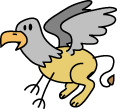
- Join Date
- Jun 2013
- Location
- Bristol, UK
 Re: Got a Real-World Weapon, Armour or Tactics Question? Mk. XXIX
Re: Got a Real-World Weapon, Armour or Tactics Question? Mk. XXIX
There was probably a particular automatic pistol that I don't know about. I remember seeing it as a toy a long time ago, it had a visible barrel (like a Luger, but I think shorter) a handle that came straight down from the body, the back of which was convex, the handle was less than twice as long (top to bottom) as it was wide (front to back) the magazine was in the handle, and apart from that I'm not sure of anything. Does anyone know what this might have been? I'd guess it was from between the wars, but I'm only sure that if it existed it wasn't modern.
 The end of what Son? The story? There is no end. There's just the point where the storytellers stop talking.
The end of what Son? The story? There is no end. There's just the point where the storytellers stop talking.
-
2022-11-28, 03:51 PM (ISO 8601)Barbarian in the Playground

- Join Date
- Feb 2010
- Location
- Slovakia
- Gender

 Re: Got a Real-World Weapon, Armour or Tactics Question? Mk. XXIX
Re: Got a Real-World Weapon, Armour or Tactics Question? Mk. XXIX
If it is kinda weird looking, there are good odds it's Czechoslovak.
Spoiler: CZ 24
But maybe not.
Spoiler: Walther P38
Spoiler: Mauser 1910
Spoiler: Savage arms 1907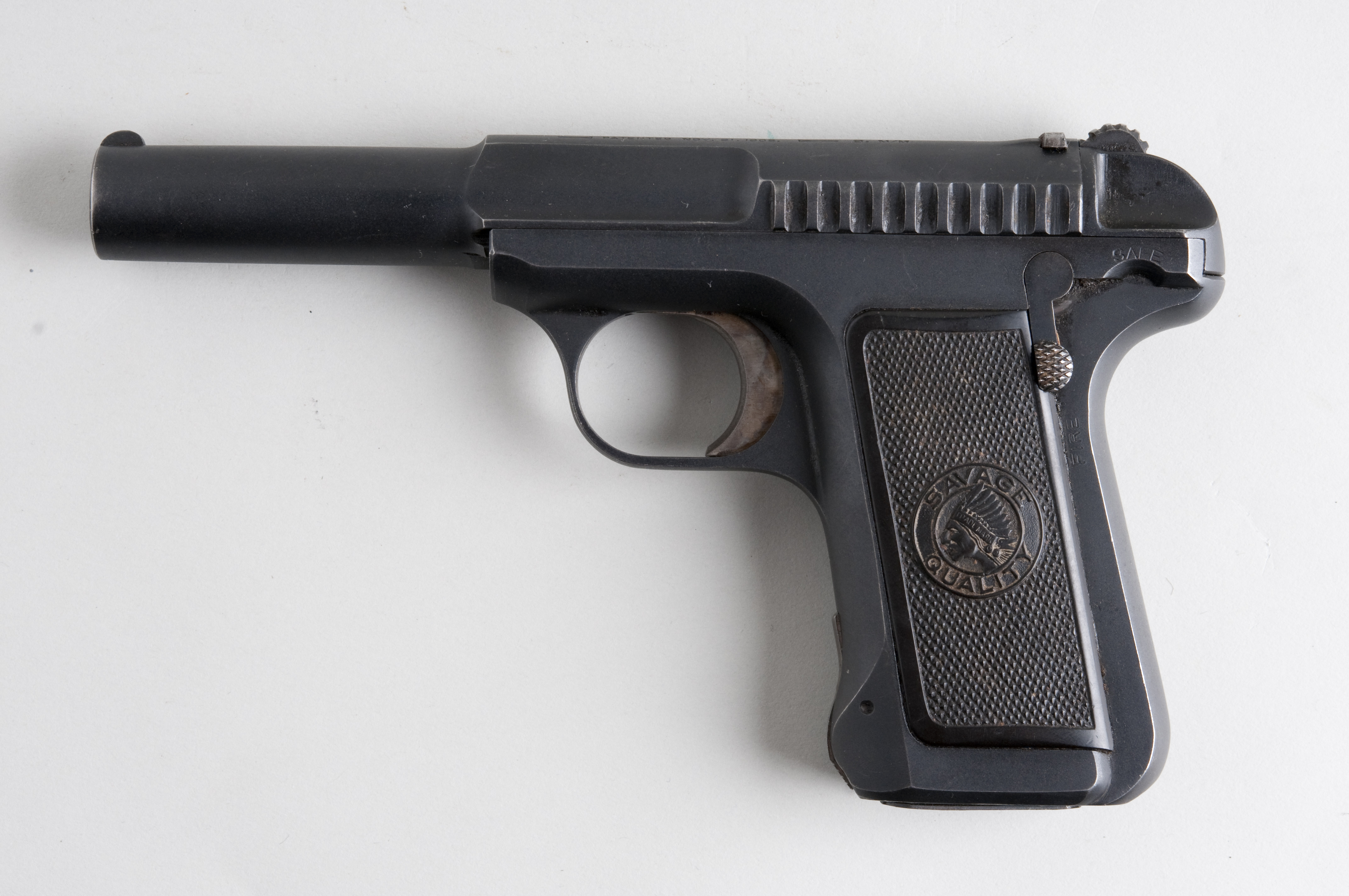
But with toy pistols, who the hell knows - they may well have just cobbled together 1911 and a luger to make it look more interesting.That which does not kill you made a tactical error.
-
2022-11-28, 04:16 PM (ISO 8601)Ettin in the Playground


- Join Date
- Jun 2013
- Location
- Bristol, UK
 Re: Got a Real-World Weapon, Armour or Tactics Question? Mk. XXIX
Re: Got a Real-World Weapon, Armour or Tactics Question? Mk. XXIX
Thanks, it was the P38, I was thinking it's nothing like the PPK, it can't be a Walther, but it was.
Funny thing is, with toys they often don't make them up. I remember having a "Man From Uncle" toy gun, it wasn't the gun from the TV series at all, it was a sort of model of the Mauser C96. The end of what Son? The story? There is no end. There's just the point where the storytellers stop talking.
The end of what Son? The story? There is no end. There's just the point where the storytellers stop talking.
-
2022-11-28, 04:32 PM (ISO 8601)Bugbear in the Playground

- Join Date
- Oct 2016
-
2022-12-10, 05:03 PM (ISO 8601)Firbolg in the Playground


- Join Date
- Sep 2009
- Location
- Denver.
- Gender

 Re: Got a Real-World Weapon, Armour or Tactics Question? Mk. XXIX
Re: Got a Real-World Weapon, Armour or Tactics Question? Mk. XXIX
Is there a name for a weapon that is a warhammer on one side and a battle axe on the reverse face? Something like a lucerne hammer.
The rest of my gaming group insists that it is called a "hamaxe", but AFAICT that is a fictional weapon from Terraria or a regional name for a splitting maul, which is a tool and not the same thing.Looking for feedback on Heart of Darkness, a character driven RPG of Gothic fantasy.
-
2022-12-10, 06:19 PM (ISO 8601)Bugbear in the Playground

- Join Date
- Oct 2016
-
2022-12-12, 04:36 AM (ISO 8601)Barbarian in the Playground

- Join Date
- Feb 2010
- Location
- Slovakia
- Gender

 Re: Got a Real-World Weapon, Armour or Tactics Question? Mk. XXIX
Re: Got a Real-World Weapon, Armour or Tactics Question? Mk. XXIX
This link may come in handy. It has pictures and is from as official an authority as you can get.
That which does not kill you made a tactical error.
-
2022-12-12, 07:11 AM (ISO 8601)Barbarian in the Playground


- Join Date
- Dec 2019
 Re: Got a Real-World Weapon, Armour or Tactics Question? Mk. XXIX
Re: Got a Real-World Weapon, Armour or Tactics Question? Mk. XXIX
Wasn't pollaxe sometimes used for hammer head + beak as well as hammer head + axe?
-
2022-12-12, 09:15 AM (ISO 8601)Ogre in the Playground


- Join Date
- Aug 2013
 Re: Got a Real-World Weapon, Armour or Tactics Question? Mk. XXIX
Re: Got a Real-World Weapon, Armour or Tactics Question? Mk. XXIX
Literally one of those pictured in the link M. Greywolf posted.
Just something to keep in mind is that the people who actually used these weapons were not really that particularly bothered by specific classifications of what kind of spike or not was present at what end. That's more a concern for people sitting in warm armchairs who don't have to use them in anger.
That is to say, it's hard to draw a line between halberds, Lucern hammers, Bec de Corbins, pollaxes, war hammers, billhooks etc etc etc and other such items (not tat they are identical but there is enough overlapping to make specific categorisation hit and miss). Anyone trying to argue an item can and must be one specific thing is usually arguing from ignorance and having read too many D&D or other rpg manuals.Last edited by snowblizz; 2022-12-12 at 09:17 AM.
-
2022-12-12, 02:51 PM (ISO 8601)Bugbear in the Playground

- Join Date
- Oct 2016
 Re: Got a Real-World Weapon, Armour or Tactics Question? Mk. XXIX
Re: Got a Real-World Weapon, Armour or Tactics Question? Mk. XXIX
Aside from the modern classification issues, Poleaxe can mean a knightly weapon typically from the 14th and 15th centuries and it can mean a butcher’s tool for slaughtering cattle. Very recently people have started referring to the weapon as pollaxe and the butcher’s tool as poleaxe, but historically both spellings have been acceptable for both items.
Poleaxe, the butcher’s tool, is typically hammer + blunt spike on the reverse.
Pollaxe the weapon is typically hammer + axe blade on the reverse + pointed spike on the top.
-
2022-12-12, 03:28 PM (ISO 8601)Firbolg in the Playground


- Join Date
- Sep 2009
- Location
- Denver.
- Gender

 Re: Got a Real-World Weapon, Armour or Tactics Question? Mk. XXIX
Re: Got a Real-World Weapon, Armour or Tactics Question? Mk. XXIX
Thank you!
Looking for feedback on Heart of Darkness, a character driven RPG of Gothic fantasy.
-
2022-12-13, 09:26 AM (ISO 8601)Barbarian in the Playground

- Join Date
- Feb 2010
- Location
- Slovakia
- Gender

 Re: Got a Real-World Weapon, Armour or Tactics Question? Mk. XXIX
Re: Got a Real-World Weapon, Armour or Tactics Question? Mk. XXIX
Well, there is terminology and there is function.
In terms of terminology, pollaxe is an entirely English invention. Historical sources refer to what we call a pollaxe as just axe, e.g. in Fiore as azza (IT) and there is a French pollaxe manual that is called Le jeu de la hache (The play of the axe). Most slavic languages (I can only confirm Slovak and Czech with full certainty) would call it two-handed axe, or knightly axe (obojrucna sekera, rytierska sekera) or possibly two handed/knightly hammer - or again, simply axe (sekera).
As far as function goes, there are two distinct kinds of polearms of this era. The first is where the pollaxe and shortspear live, a weapon meant for fighting duels or skirmishes. These tend to be about as tall as the one using them.
The second type is your halberd category, they are about a meter longer than the user and meant for formation fighting primarily, hence the length.
The problem is that modern classification usually distinguishes by form, i.e. if it has a specific kind of hook, it is a billhook, even if it is short and heavy because someone wanted to use a billhook in an armored duel. And even if you wanted to divide them by length, where do you put your arbitrary separation point?
We have a lot of terminological problems because while some weapons are defined by form only (e.g. you can have a short halberd or spear, and then use it like a pollaxe), others are also tied to their function (a long pollaxe wouldn't make sense).
Spoiler: These are both halberds from the same time and place

One of those halberds reaches to the user's chin, the other's blade doesn't even start until it is past the ridiculously fancy hat. Those two weapons would handle very differently in use, even is everyone calls them by the same name.
This isn't limited to polearms, by the by, I've seen some examples of Magyar sabers that looked the exact same while having a difference in weight of half a kilo and a completely different point of balance.
So what is a modern definition of pollaxe?
It is a poleram, about as long as the user at most, meant for fighting in armor against armor. It can have a spear-like spike on the front and back of its shaft (it almost always has the front one, and the front one is sometimes just a spear blade), and its front side has two impact heads, oriented kinda like long and short edge of a sword. These heads can be any combination (including two of the same type) of:
- axe (curved, straight or reverse curved blade)
- hammer
- spike
- crow's beak (i.e. a curved spike)
- multiple spikes
- maybe a flat, dagger-like blade, but I can't remember if I saw one on pollaxe or if it is a halberd thing
They may or may not have a rondel guard on the shaft and two spikes coming off of the shaft in the right angle to the heads.
Spoiler: Some examples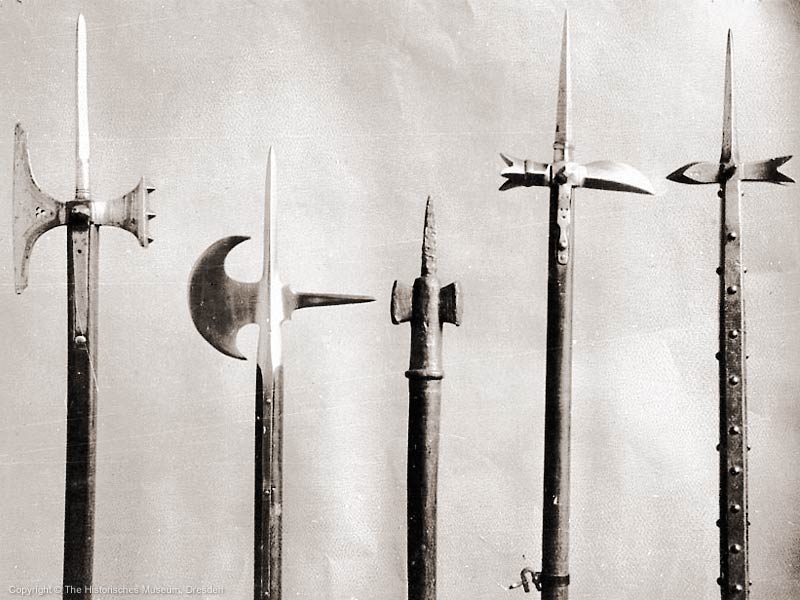


But wait, Greywolf, some of you say. Are you saying that you can have a pollaxe that is just spikes all over?
Spoiler: Yes, yes you can, sort of
We just call them goedendags, or two-handed morningstars.That which does not kill you made a tactical error.
-
2022-12-13, 01:29 PM (ISO 8601)Ogre in the Playground

- Join Date
- Feb 2016
- Location
- Earth and/or not-Earth
- Gender

 Re: Got a Real-World Weapon, Armour or Tactics Question? Mk. XXIX
Re: Got a Real-World Weapon, Armour or Tactics Question? Mk. XXIX
If historical people didn't have distinct terminology for these various sorts of similar weapons, how did they distinguish between them when they had cause to do so?
I made a webcomic, featuring absurdity, terrible art, and alleged morals.
-
2022-12-13, 02:37 PM (ISO 8601)Ettin in the Playground


- Join Date
- Mar 2005
- Location
- 61.2° N, 149.9° W
- Gender

 Re: Got a Real-World Weapon, Armour or Tactics Question? Mk. XXIX
Re: Got a Real-World Weapon, Armour or Tactics Question? Mk. XXIX
I would suspect in a similar way that we currently distinguish between 9mm pistols. By maker/region/user, part specification (short, long, heavy, etc.), and not relying on one single word to fully describe the exact item from a bunch of similar items.
Like a Toyota Corolla car is a Toyota Corolla car, right? But we use additional words to describe 2-door vs 4-door and the 1980s models from the 2020s models.Last edited by Telok; 2022-12-13 at 02:37 PM.
-
2022-12-13, 02:54 PM (ISO 8601)Bugbear in the Playground

- Join Date
- Oct 2016
 Re: Got a Real-World Weapon, Armour or Tactics Question? Mk. XXIX
Re: Got a Real-World Weapon, Armour or Tactics Question? Mk. XXIX
Generally speaking weapons were names for their function not their form
A modern example is the Chef’s Knife. The 3 main schools of design are Japanese, German, and French. Each broad category has distinct blade geometry and handle design. Each design category handles differently and have different strengths and weaknesses. Within each category there are significant variations. The size can vary from 6 inches/15cm to 12inches/30cm. There are differences in preferred steel types.
However all of them are large general purpose kitchen knives, so they are all “Chef’s knives”. If you want to differentiate them you tack on the appropriate descriptor(s) you want to use to distinguish at the time you need it.
In 5000 years time when knives are forgotten and obsolete technology a bunch of nerds might come along and start giving different names to different forms of Chef’s knife, but currently we just use the name that describes the function.
Edit to add.
If there were 3 knives on a bench, a 8” German style, a 10” Japanese style and a 12” French style, here are some of the ways I might differentiate them to a co-worker:
Ownership - my knife, your knife, Steve’s knife
Size - the big one, the small one, the middle sized one.
Handle type - the plastic handled one, the steel handled one, the wooden handled one.
Handle color - black handle, silver handle, brown handle.
Manufacturer - the Wusthof, the Shun, the Sabatier.
What I would never do is differentiate them by classification as German style, Japanese style or French style. Classification would only come up in a knife nerd conversation, and surprisingly few chefs are knife nerds. Most chefs choose knives based on ‘can I afford it’, ‘is it comfortable to use’ and ‘does it look cool’, the nerdly fine points of design just aren’t considered for a tool of daily useLast edited by Pauly; 2022-12-13 at 03:38 PM.
-
2022-12-14, 05:05 AM (ISO 8601)Barbarian in the Playground

- Join Date
- Feb 2010
- Location
- Slovakia
- Gender

 Re: Got a Real-World Weapon, Armour or Tactics Question? Mk. XXIX
Re: Got a Real-World Weapon, Armour or Tactics Question? Mk. XXIX
The salient point here is:
And the number one thing you need to realize is that this came up... almost never.
If you go looking for a kitchen knife today, you will find thousands, if not tens of thousands, of different types, from hundreds of countries and dozens schools of thought, because Google and internet (and catalogs in mail before that) are like that. But in pre-industrial era? If you want a kitchen knife, you have maybe two or three local knife-makers, all of whom make knives roughly the same way, simply because they are trying to compete with each other and if something becomes popular, they all switch to it.
Imports did happen, but that was for very famous items only - say, Solingen and Toledo get a very good reputation for swords, so they export their swords all over, and they are known as Solingen sword. Most of those exports are what swords look like locally at Solingen/Toledo, or customs made to specification, so in terms of form, you have three types of sword in any one place, Solingen-form, Toledo-form and local-form (this is obviously a simplified example, but you get the point).
Next factor in this is that not many of these items (let's focus on weapons) existed in the same time. A soldier in 1600 AD Germany has zero need to distinguish between a gladius and a katzbalger, he will simply say "sword" and everyone around him will know what he means. Well, not really, because our soldier sees use of three distinct types of swords, a katzbalger, a rapier (well, arming sword with complex hilt) and a massive two-hander. Most of the time, it will be clear what he is talking about from context, much like we know that "a cop carrying a gun" means a semiautomatic pistol of some kind (maybe a revolver in parts of USA) and not a 50cal anti-materiel rifle.
Spoiler: A picture of soldier holding what is, indeed, a gun
If such a soldier needs to describe the sword more precisely, there is either jargon (see katzbalger) or there are descriptive words, like long sword. Those descriptives need to be examined in context, a Roman will say "long sword" and mean a 90cm spatha, a 1400 German will mean two-handed weapon and an 1800 gentleman will probably mean anything longer than a smallsword (backsword, maybe?).
Spoiler: All the weapons you need to know about, according to Codex Wallerstein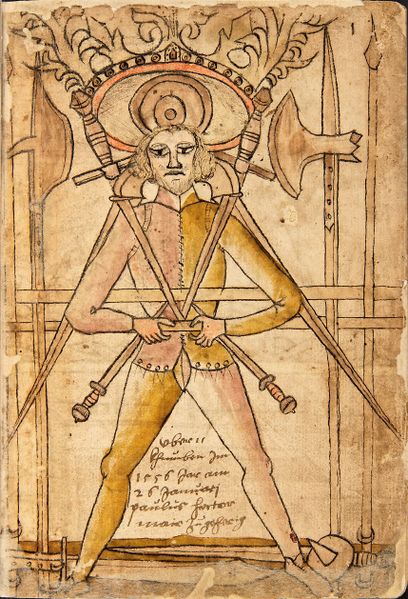
So, taking our French pollaxe manual, it is called Le Jeu de la Hache, the Play of the Axe. Well, it uses the word "play" in the title, in the sense of martial arts kata which we can use to infer the axe has to be a military one. In the time it was written, there were three weapons describable as axe: one handed horseman's axe, pollaxe and halberd. We have no additional descriptives from title alone, so we must ask ourselves, what was THE axe in the mind of the noble soldier (since treatises weren't written for commoners at this time)? And the answer to that is pollaxe - it may not be the right answer from that alone, maybe the author was writing that treatise in different context than we assume, but lucky us, we can open the book. Sure enough, it *is* a pollaxe.
There is another factor to this as well - English, as much as many like to pretend otherwise, isn't the only language, and that causes problems. You know the English word for sabre, it is... well, sabre. The word comes from, most likely, Magyar/Hungarian word szablya, which got transported into Slavic languages. In Slovak, the word sabla, meaning "sabre" is also used colloquially as the word for any kind of long bladed weapon, so in some contexts it translates to "sword". (sidenote, hungarian doesn't even use the word szablya for the Olympic discipline)
This is all fine and good before a specific model of a sword is attached to word that sounded foreign and exotic to Victorian scholars and now we call the entire sword type by the word that, when translated, means "sword". The usual suspects are here: shamshir (sword), talwar (single edged sword), katana (single-edged sword) and so on. The crowning achievement here is the sword that is called firangi, which means "European" in translation. Because it was European blade mounted on local hilt.
Spoiler: Gaze upon it, and despair
Remember when I mentioned Victorian scholars? Well, that is where the mess really started. The peak of British Empire coincided with ancient Greek philosophers and intellectualism being the new cool thing, and if there is one thing Aristotle loved, it was categories. Which means that the people who created, if not modern science then its direct predecessor, wanted to put things in neat categories and started to make jargon and terminology for them. This is why there are a dozen words for different swords that British empire was near, but many varieties of Persian blades get rolled into shamshir. They started the categories from what they knew and only created a new one when a sword didn't easily fit into those - katana was called Japanese saber in Europe for a long time. And when these new categories were created, they were often named by the foreign language word.
Over time, we tried to solve that problem, but once a word is in widespread use, it is a lost fight, and most classification systems robust enough (e.g. Oakeshott or Petersen typologies for swords) are too clunky for everyday use. Hell, even most people doing HEMA - the people who know the most about how a sword works - don't use that system unless they really, really have to.
Spoiler: This is simplified Oakeshott typology... yeah...
The gist of it is this: if you decided to pick a single time and place for DnD from history, two thirds of weapon list would be gone and you could use generic words. If you try to encompass a solid chunk of time and space (and appease the fanboys who will not accept that katana is a sabre), well, you will run into some problems.
Spoiler: Is this a katana? Hungary, 15th c.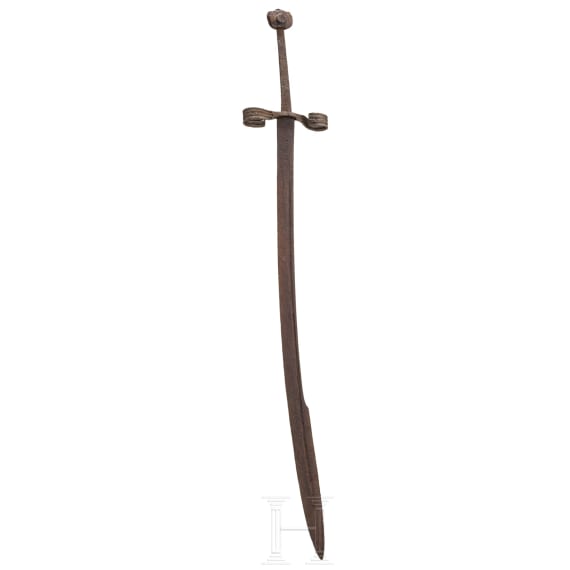 That which does not kill you made a tactical error.
That which does not kill you made a tactical error.
-
2022-12-14, 03:45 PM (ISO 8601)Ogre in the Playground

- Join Date
- Aug 2022
 Re: Got a Real-World Weapon, Armour or Tactics Question? Mk. XXIX
Re: Got a Real-World Weapon, Armour or Tactics Question? Mk. XXIX
Made worse by the tendency of the Aristotle mindset (inherited from Plato), in which the "scientific" (quotes used intentionally here) approach was basically "if you don't know something about something, fill it in with <something descriptive>". The thought was that it was more important to be "complete" with a description of something than "accurate". There's a whole lot of descriptive nonsense that you basically have to toss out the window that came from that approach. Sadly, I suspect the Victorians just ate it up, which in turn lead to a whole new round of "fanciful" thinking during that era. Add in the telephone game process when dealing with historical accounts/descriptions, and it could get pretty ridiculous.
-
2022-12-14, 04:03 PM (ISO 8601)Bugbear in the Playground

- Join Date
- Oct 2016
 Re: Got a Real-World Weapon, Armour or Tactics Question? Mk. XXIX
Re: Got a Real-World Weapon, Armour or Tactics Question? Mk. XXIX
But when you’re searching for a kitchen knife you just get a simple breakdown into broad functional categories - e.g. paring knife, boning knife, salmon slicer, chef’s knife, filleting knife, or yanagiba (sashimi knife).
If you want to differentiate any further in detail you need to start applying descriptors, not categories. If I want a chef’s knife with a French style blade, a German style handle made from Japanese style high hardness steel, google doesn’t help me because it’s search algorithms don’t use categories, only descriptors.
Coming back to poleaxes if you were a 15th century noble looking to buy a new poleaxe you’d say to the merchant or weaponsmith ‘I want a poleaxe with these features’ not ‘I want [category type] poleaxe’.
-
2022-12-14, 08:36 PM (ISO 8601)Bugbear in the Playground

- Join Date
- Oct 2016
 Re: Got a Real-World Weapon, Armour or Tactics Question? Mk. XXIX
Re: Got a Real-World Weapon, Armour or Tactics Question? Mk. XXIX
The Greek mindset was to find the most succinct unambiguous expression. Which makes sense when the major method of transferring information was oral and the major method of storing information was memory.
Hence the chreia of Plato arriving at a definition of a man as a ‘featherless biped’ and being greatly praised for such clever definition. Diogenes then came to Plato’s academy whilst Plato was instructing his students, threw in a plucked rooster saying ‘behold, Plato’s man’. After which Plato amended his definition of a man to a ‘featherless biped with broad nails’.
-
2023-01-10, 10:10 AM (ISO 8601)Troll in the Playground


- Join Date
- Mar 2012
- Location
- UK
- Gender

 Re: Got a Real-World Weapon, Armour or Tactics Question? Mk. XXIX
Re: Got a Real-World Weapon, Armour or Tactics Question? Mk. XXIX
A thought occurred to me - how easy is/was it to store a strung bow?
I believe some historical groups had scabbard-type containers for recurved composite bows, but I think they were horse-scabbards not person ones (if they existed at all)?
The relatively common fantasy picture of carrying a strung bow by putting one's head and arm through so it sits diagonally across the torso - bow on the back, string on the front - doesn't seem practical when I think about it.
So, were strung bows carried around (except for in hand when they are directly ready for use)?
-
2023-01-10, 10:33 AM (ISO 8601)Firbolg in the Playground


- Join Date
- Nov 2009
- Gender

 Re: Got a Real-World Weapon, Armour or Tactics Question? Mk. XXIX
Re: Got a Real-World Weapon, Armour or Tactics Question? Mk. XXIX
I suspect it depends on culture, place, and time. Many weapons were carried in hand without a sheath, and a Duehrer print of Irish soldiers hints that this was the case with bows, too. https://www.wikiart.org/en/albrecht-...s-and-peasants
There also is a Greek vase showing a Scythian carrying his bow in a sheath. https://www.gettyimages.ie/detail/ne...hoto/543542594 And photos of Mongolian archers with a sheath and a strung bow https://www.jstor.org/stable/48578005 How much it was for pose, that's a different matter.
One with more time or experience could give you a more complete answer. I've never really got how a bow can be carried like in fantasy movies, however. I would expect it to get too low for comfort, unless it squeezes the bearer really well. Originally Posted by J.R.R. Tolkien, 1955
Originally Posted by J.R.R. Tolkien, 1955
-
2023-01-10, 02:14 PM (ISO 8601)Troll in the Playground


- Join Date
- Mar 2012
- Location
- UK
- Gender

 Re: Got a Real-World Weapon, Armour or Tactics Question? Mk. XXIX
Re: Got a Real-World Weapon, Armour or Tactics Question? Mk. XXIX
Thank-you - I think the first picture you showed supports our general position that you cannot carry a bow in the fantasy over the shoulder/body method.
The second picture shows nicely that recurve bows can be compact enough to fit in sheathes of various sorts whilst the third gives an excellent way to store a bow for a long walk/march, but not one that woud be practical in enclosed spaces.
-
2023-01-10, 07:02 PM (ISO 8601)Troll in the Playground

- Join Date
- Jul 2012
- Gender

 Re: Got a Real-World Weapon, Armour or Tactics Question? Mk. XXIX
Re: Got a Real-World Weapon, Armour or Tactics Question? Mk. XXIX
Been a while since I did any archery, but I'm pretty sure slinging the bow over yourself with the bowstring would negatively impact the bow. You aren't really supposed to keep them stretched beyond their normal resting but strung position, it stretches the string and can make it more slack, and can warp the bow itself in a way that proper use doesn't. Hunters do it for convenience sometimes to my knowledge, but target shooters frown on the practice.
It's not going to cause catastrophic damage in a short time or anything, but a good bow isn't cheap, so unnecessary wear and tear isn't something you want to happen. It's the sort of behaviour a professional military bowman would probably give his son a slap around the head for doing.Sanity is nice to visit, but I wouldn't want to live there.
-
2023-01-10, 11:39 PM (ISO 8601)Bugbear in the Playground

- Join Date
- Oct 2016
 Re: Got a Real-World Weapon, Armour or Tactics Question? Mk. XXIX
Re: Got a Real-World Weapon, Armour or Tactics Question? Mk. XXIX
Archery isn’t my speciality, but all I have read is that historical bows were kept unstrung until needed
A number of reasons have been cited including.
- stress on the bow is bad for it, so you want to limit the amount of stress it sees.
- bowstrings becoming stretched.
- danger of getting wet, which was generally considered catastrophic for the bow string and bad for the bow.
I remember sources specifically mentioning English Longbowmen stringing their bows just before action during the 100 Years War and the War of the Roses.Last edited by Pauly; 2023-01-10 at 11:54 PM.
-
2023-01-11, 03:35 AM (ISO 8601)Troll in the Playground


- Join Date
- Mar 2014
 Re: Got a Real-World Weapon, Armour or Tactics Question? Mk. XXIX
Re: Got a Real-World Weapon, Armour or Tactics Question? Mk. XXIX
Although really, when was the last time one needed to conveniently carry a composite bow indoors? Check it at the door. If a bow-carrying method works on a hike and not at a dance party, it's of only negligibly less usefulness than some hypothetical method that works for both.
-
2023-01-11, 07:35 AM (ISO 8601)Barbarian in the Playground

- Join Date
- Feb 2010
- Location
- Slovakia
- Gender

 Re: Got a Real-World Weapon, Armour or Tactics Question? Mk. XXIX
Re: Got a Real-World Weapon, Armour or Tactics Question? Mk. XXIX
Pretty damn easy, it's just a stick with some string. Put it on a scabbard, hang it from wherever. That's not he problem.
The problem is that the stick is relatively thin, and if you keep it like that for weeks on end, it's going to steadily loose power. That's a bit of a problem if you want to arm your army with a weapon that will last them a few years, and doubly so if you want to stock your armory with some reserve gear.
This is a pretty easy to answer question - every culture that used a short bow put it in a scabbard at their hip, sometimes switching it to the saddle when on horseback. It's a result of the bow's shortness rather than anything related to horses or nomads.
This is why you sometimes see plains Indians in America using scabbards as well, their bows were not composite, but relatively short, and relatively weak.
Not only is it hard to get the bow out from there, but it also interferes with your hood, possibly shield straps and to top it off, a long bow will get caught on ground and/or shrubs. Which I know, because I tried it.
Another issue is that the bow is your main weapon, kind of like a spear or a pollaxe, so there is no reason to have it sheated, really. You are going out there to shoot something/someone, may as well just keep it in your hand. It's a bit like asking why does modern infantry not have a holster for their assault rifles.
Well, there was the ever popular in the hand and strung, even used by nomads sometimes
Spoiler: Chronica Picta, 1340
You can see it is clearly strung from the shape, and I can see the actual string drawn on the picture in my facisimile
Spoiler: Ab Urbe Conditia, 1400
If you had a short enough bow, you could have it strung and in a sheat:
Spoiler: 1907 photo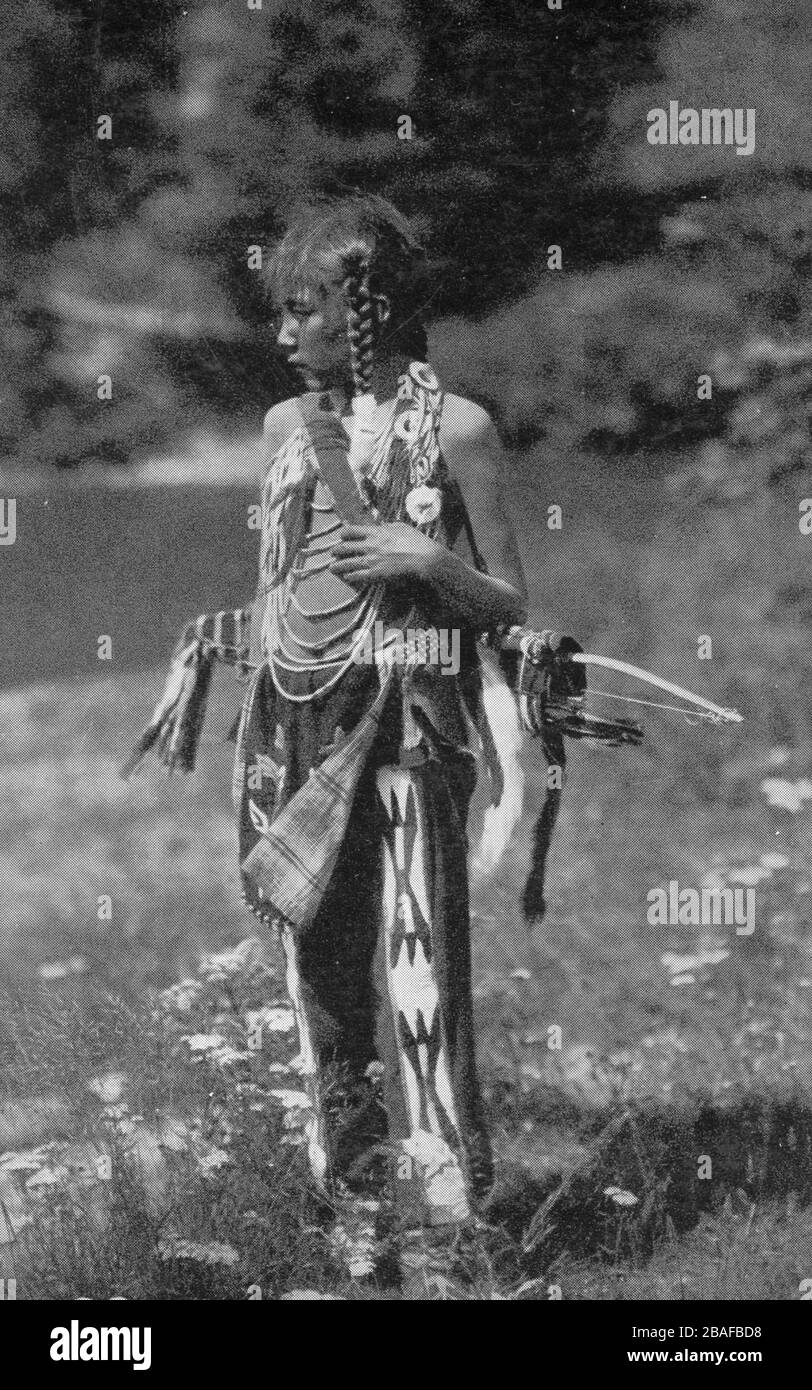
Spoiler: Darjiu church fresco, 1400
Spoiler: Giovanni Boccacio, 1450
If you were expecting no trouble, or had it stored, you could just have it unstrung and carry it that way:
Spoiler: Eadwine psalter, 1150
Spoiler: Queen Mary psalter, 1320
And if you had a bow that was long, and expected no trouble, and were travelling by horse, you could always just tie it to the saddle or the quiver.
Spoiler: Facta et dicta memorabilia, 1320That which does not kill you made a tactical error.
-
2023-01-11, 03:58 PM (ISO 8601)Titan in the Playground

- Join Date
- Feb 2011
 Re: Got a Real-World Weapon, Armour or Tactics Question? Mk. XXIX
I just now came here to ask a remarkably similar question, but expanded to other kinds of weapons as well:Originally Posted by Khedrac
Re: Got a Real-World Weapon, Armour or Tactics Question? Mk. XXIX
I just now came here to ask a remarkably similar question, but expanded to other kinds of weapons as well:Originally Posted by Khedrac
A thought occurred to me - how easy is/was it to store a strung bow?
In general, how were weapons like swords, axes, spears, etc. physically stored? I’m mainly thinking of weapons that would be stockpiled for the defense of a fortification, but I’m open to other cases of weapon storage as well. What kinds of spaces were they kept in, and under what conditions?
And as a second part to this question—how long could these weapons remain combat-viable when stored in these spaces and under these conditions? Were there any approaches taken to try to extend their lifespans when stored? How effective were those efforts to prolong the weapons’ storage lives, and can we estimate what their maximum “shelf life” might have been?
Obviously this varies widely depending on culture, climate, period in history and many other factors, so I’m open to whatever answers anyone can provide.





 Reply With Quote
Reply With Quote










 RSS Feeds:
RSS Feeds: 

